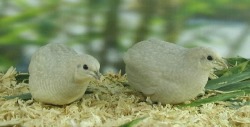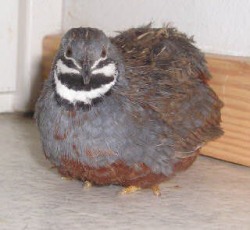The Chinese Painted Quail

Silver Chinese Painted Quail
Coturnix chinensis Size: 5 inches (12.5 cm) Breeds and mutations: Various mutations are available including: normals, silvers, whites, pieds’, pearls and various combinations such as blue pearl.
Sexing:
Normally easy to sex but depends upon the mutation. In normal CPQ the cock bird has a white mask and red rump, while the hen lacks the red rump and has a brown mask, if any. However mutations now exist where the cock bird lacks a mask so these can only be sexed by observing behaviour and the red rump if that is shown in the mutation. Cock birds in breeding condition will pick up livefoods (e.g. mealworms) and other food items and hold them in his beak while calling to the hen. Hens can do this, but only when she has chicks. Mutations such as whites can only be sexed by DNA samples and observing behaviour.
Food:
CPQ will eat just about anything you offer them! A basic staple diet consists of foreign finch seed mix, along with chick crumbs, eggfood, cuttlefish bone (if they touch it!), grit, oyster shell, greens such as chopped cucumber, lettuce, broccoli, dandelions. They also love livefoods as a treat such as regular amp mini mealworms, waxworms, crickets, earthworms, spiders, infact just about anything that moves and is small enough to eat! .
Housing:
CPQ like to be able to roam around the floor and so are best housed in aviaries in pairs or in a colony with 1 cock to every 3 hens. If kept in cages the cage size should be no less than 4 foot long, 18 inches deep and 18 inches tall for any one pair of birds. CPQ housed in aviaries enjoy plants such as pampas grass and other ornamental grasses, dwarf bamboos, passionflowers, clematis, conifers. All of the following plants provide cover and make the quail feel more secure, you are also more likely to breed CPQ naturally and have your hen sit if you have lots of grasses for them to hide and nest in. Also, board up the bottom 1 1/2 foot of the aviary to prevent harassment from cats and make the quail feel safer overall. Perches are not necessary as quail are ground dwelling birds and only fly to escape predators or when startled (usually).
Aviary mesh:
1 x 1/2 inch mesh for adult birds, but chicks can walk through mesh this size so it is safer to use 1/2 x 1/2 inch mesh unless you intend to board up the bottom half of your aviary.
Breeding:
There are 2 ways to breed CPQ: The natural way, and artificially.
I will only go through natural breeding as I do not see the purpose of artificially rearing CPQ other than to make money, as they lose their instinct to sit eggs and this can frustrate bird keepers who buy them.
Breeding starts from march and ends around October, but it depends largely on diet and light levels. This method works best if you can acquire parent-reared birds otherwise the instinct of the bird's desire to nest is not guaranteed! Place a pair of birds in an aviary (preferably 6 foot x 3 foot x 6 foot minimum) containing various grasses for cover.
Feed the birds on livefoods every day (you can train birds to eat from your hands by doing this) and when the hen is ready she will find a spot, usually in one of the grass plants, and dig it into a hollow maybe and line it with some grass. An egg will be laid everyday until she is ready to sit and then she will stop laying and sit the eggs for around 21 days. Normally 10-12 eggs are laid but i have known my birds to lay over 20. Try not to disturb the hen while she is laying or sitting, as she is likely to abandon the nest, and find another nest site, (that means no peeking! other than from a distance).
On around 21 days after she started sitting the eggs will hatch but it has been known to take one or two days longer or less. The chicks can walk as soon as they hatch and will follow the hen around and hide in her feathers for warmth, the hen will call to her chicks to make sure she has all over them should any wonder. Feed the chicks on ground up chick crumbs until they are large enough to take ordinary chick crumb (around 1 week old), they can also be fed small amounts of mini mealworms, which have just shed (are white in colour), and blue maw seed.
The water dish needs to be at ground level, dig it in if you have to! And make sure that the water bowl is filled with pebbles and gravel to prevent the chicks from drowning. As they grow offer the same diet as adult birds, they should start to feather up after about 1 week and will mature at around 6-8 weeks. You may need to separate cock birds as they are known to fight, but this is less of a problem with cocks from the same family and they can be known to live together quite happily.
Sexing:
Normally easy to sex but depends upon the mutation. In normal CPQ the cock bird has a white mask and red rump, while the hen lacks the red rump and has a brown mask, if any. However mutations now exist where the cock bird lacks a mask so these can only be sexed by observing behaviour and the red rump if that is shown in the mutation. Cock birds in breeding condition will pick up livefoods (e.g. mealworms) and other food items and hold them in his beak while calling to the hen. Hens can do this, but only when she has chicks. Mutations such as whites can only be sexed by DNA samples and observing behaviour.
Food:
CPQ will eat just about anything you offer them! A basic staple diet consists of foreign finch seed mix, along with chick crumbs, eggfood, cuttlefish bone (if they touch it!), grit, oyster shell, greens such as chopped cucumber, lettuce, broccoli, dandelions. They also love livefoods as a treat such as regular amp mini mealworms, waxworms, crickets, earthworms, spiders, infact just about anything that moves and is small enough to eat! .
Housing:
CPQ like to be able to roam around the floor and so are best housed in aviaries in pairs or in a colony with 1 cock to every 3 hens. If kept in cages the cage size should be no less than 4 foot long, 18 inches deep and 18 inches tall for any one pair of birds. CPQ housed in aviaries enjoy plants such as pampas grass and other ornamental grasses, dwarf bamboos, passionflowers, clematis, conifers. All of the following plants provide cover and make the quail feel more secure, you are also more likely to breed CPQ naturally and have your hen sit if you have lots of grasses for them to hide and nest in. Also, board up the bottom 1 1/2 foot of the aviary to prevent harassment from cats and make the quail feel safer overall. Perches are not necessary as quail are ground dwelling birds and only fly to escape predators or when startled (usually).
Aviary mesh:
1 x 1/2 inch mesh for adult birds, but chicks can walk through mesh this size so it is safer to use 1/2 x 1/2 inch mesh unless you intend to board up the bottom half of your aviary.
Breeding:
There are 2 ways to breed CPQ: The natural way, and artificially.
I will only go through natural breeding as I do not see the purpose of artificially rearing CPQ other than to make money, as they lose their instinct to sit eggs and this can frustrate bird keepers who buy them.
Breeding starts from march and ends around October, but it depends largely on diet and light levels. This method works best if you can acquire parent-reared birds otherwise the instinct of the bird's desire to nest is not guaranteed! Place a pair of birds in an aviary (preferably 6 foot x 3 foot x 6 foot minimum) containing various grasses for cover.
Feed the birds on livefoods every day (you can train birds to eat from your hands by doing this) and when the hen is ready she will find a spot, usually in one of the grass plants, and dig it into a hollow maybe and line it with some grass. An egg will be laid everyday until she is ready to sit and then she will stop laying and sit the eggs for around 21 days. Normally 10-12 eggs are laid but i have known my birds to lay over 20. Try not to disturb the hen while she is laying or sitting, as she is likely to abandon the nest, and find another nest site, (that means no peeking! other than from a distance).
On around 21 days after she started sitting the eggs will hatch but it has been known to take one or two days longer or less. The chicks can walk as soon as they hatch and will follow the hen around and hide in her feathers for warmth, the hen will call to her chicks to make sure she has all over them should any wonder. Feed the chicks on ground up chick crumbs until they are large enough to take ordinary chick crumb (around 1 week old), they can also be fed small amounts of mini mealworms, which have just shed (are white in colour), and blue maw seed.
The water dish needs to be at ground level, dig it in if you have to! And make sure that the water bowl is filled with pebbles and gravel to prevent the chicks from drowning. As they grow offer the same diet as adult birds, they should start to feather up after about 1 week and will mature at around 6-8 weeks. You may need to separate cock birds as they are known to fight, but this is less of a problem with cocks from the same family and they can be known to live together quite happily.

